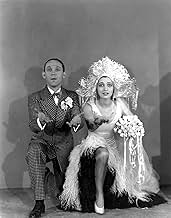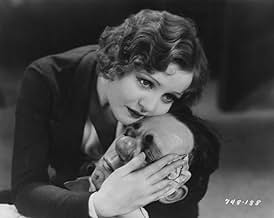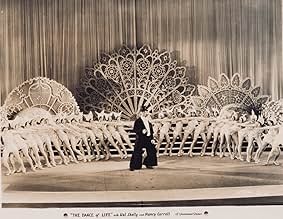Agrega una trama en tu idiomaWhen a vaudeville comic and a pretty young dancer have little luck in their separate careers, they decide to combine their acts; to save money on the road, they get married.When a vaudeville comic and a pretty young dancer have little luck in their separate careers, they decide to combine their acts; to save money on the road, they get married.When a vaudeville comic and a pretty young dancer have little luck in their separate careers, they decide to combine their acts; to save money on the road, they get married.
- Dirección
- Guionistas
- Elenco
- Premios
- 3 premios ganados en total
- Harvey Howell
- (as Ralph Theadore)
- Amazon Chorus Girl
- (as Miss La Reno)
- Amazon Chorus Girl
- (as Cora Beach Shumway)
Opiniones destacadas
A big film in its time, Paramount popped for Technicolor and assigned it's two top directors, Cromwell and Sutherland. [The directors appear in cameos as doorman and theatre attendant, respectively.] Musical sequences are well done and entertain. Cringe factor on a one to five scale, one. The wonder of seeing the tall, lanky Skelly and diminutive Carroll dancing in perfect unison is still with me. They're the most unlikely team this side of Laurel and Hardy.
Many other splendid differences between this film and its contemporaries are worth noting. Released August, 1929, Paramount's superimposed credits seem so much more modern than the silent card graphics MGM still used. Not everyone cares to know who the associated producer is, we want entertained. Behind The Dance Of Life, silhouetted stage hands scurry about, pulling backdrops and riggings. You're treated to seeing behind the scenes while the obligatory texts play out. The ensemble cast has antagonists which prove to be red herrings. It's loaded with interesting camera compositions. A train is gained and quit at night in a pouring rainstorm. A sandwich is used as a romantic device. And what I enjoyed the most was the personal and up close feeling the directors give scenes. Skelly, after pratfalling from wing to wing, sings "True Blue Lou" so personally it would seem he was oblivious to the camera which closed in three times during the song.
A snapshot of a lost form of American entertainment, The Dance Of Life stands apart from its roots as a great film. See it!
Skid Johnson is a baggy-pants comedian who can't make it on the vaudeville circuit. He meets Bonny Lee, a bright young dancer who is pretty and talented but who just can't catch a break. Stranded in a train station between vaudeville bookings, the two decide to team up and try a new act together. To save money, they get married: if they travel the vaudeville circuit with a marriage license to prove they're husband and wife, they can share a single hotel room. As their act gets better, Skid and Bonny get bookings which bring them closer to Broadway, and soon they are genuinely in love with each other. But, just when stardom is within their grasp, Skid gets a big head. And then the trouble starts...
'The Dance of Life' is a fascinating early talkie. Nancy Carroll (in the Stanwyck role) is an excellent actress and a fine dancer. Dramatic actor Hal Skelly had difficulty getting roles because of his clownish face; in this film, he puts his unusual appearance to good tragicomic advantage as a comedian who encounters problems in his offstage life. Skelly does a funny skidding dance which probably explains his character's nickname.
Oscar Levant had a small role in the Broadway cast of 'Burlesque', in a party scene which gave him a chance to play the piano and make a few wisecracks. He makes his film debut in 'The Dance of Life', repeating his Broadway role ... but the screenplay cuts Levant's role to a mere walk-on, giving him no opportunities to play the piano or crack any jokes. Don't expect any of those great Levant witticisms.
I was excited to see Al Saint John's name in this film's cast list, in the role of Skid Johnson's slapstick comedy sidekick Bozo. Al Saint John was one of the great acrobatic comedians of the silent screen, working prominently with his uncle Roscoe 'Fatty' Arbuckle and with Buster Keaton. Seeing him cast as a comedian in this dramatic backstage story, I expected St John to do some of his brilliant acrobatic pratfalls in 'The Dance of Life'. Unfortunately, we never see Bozo doing any of his act onstage, so St John's comedic talents are wasted in this film. But he handles the dramatic aspects of his supporting role very well.
Some of the dialogue in 'The Dance of Life' was considered quite racy at the time, but it will seem very tame now. Like this example:
GIRL: You wouldn't kid me, would you, mister?
BOY: I would if I could, sister, I would if I could.
In 1929, that was pretty close to a dirty joke. I recommend 'The Dance of Life' as a fascinating example of early talking pictures
Curtis Stotlar
If you're a weird masochists like me who like to torture yourself by watching early talkies, this will be a pleasant surprise for you. It feels like a big budget, high quality Paramount spectacular - a typical 1930s Hollywood movie - even though it's not actually a Hollywood movie. Paramount's new state of the art studio had just burned down so they had to relocate to their old New York studio for this.
Besides APPLAUSE and to a lesser extent THE LADY LIES and BROADWAY MELODY, most 1929 productions can only be viewed as interesting (or in most cases, boring) curios. This one however lets you sit back and, kick off your shoes and enjoy it as a proper picture. It's got proper modern style acting delivered with dialogue which sounds natural and authentic. The actors do what actors are meant to do: make you think they're real people.
One reason for this must attributed to David O'Selznick's decision to use two directors: one with a movie background and one with a theatre background - it works well. (David O'Selznick at Paramount? Working for MGM and RKO was clearly not enough for him!) The photography is as fluid and imaginative as it was before the restrictions of sound recording came in and the sound recording itself is superb. Also, another big plus is that although it's to some extent a romance, it is refreshingly not one of those nauseating, mushy, sickly sweet pictures which polluted our screens in the late twenties.
It's a bit longer than a typical early talkie but lovely Nancy Carroll thoroughly keeps your attention for the whole two hours. Like a lot of actors and actresses who became massively famous in early talkies, she virtually vanished after the mid thirties. You can understand that with many of those stars like Helen Twelvetrees for example who just didn't fit in with the style of filmmaking which the early talkies evolved into. With Nancy Carroll however it doesn't make sense because, certainly in this picture, she was so believable and engaging. She's not just beautiful and super-sexy like say Alice White, she's a real, normal person whom you think you might have gone to school with.
¿Sabías que…?
- TriviaOriginally intended as Paramount's first talkie, this production was transferred to the Astoria studios in Queens after the January '28 fire that destroyed Paramount's Hollywood studios. It was eventually transferred from Astoria back to Hollywood, incurring another delay, allowing several other features to be released before this film finally made it to theaters in mid-1929.
- Citas
Ralph 'Skid' Johnson: Say, you're out of a job--let's both wire him.
Bonny Lee King: Yeah, but I ain' got your talent.
Ralph 'Skid' Johnson: Aw, rats. With your face and figure, baby, you could make good anywhere.
- Bandas sonorasTrue Blue Lou
(uncredited)
Music by Richard A. Whiting
Lyrics by Sam Coslow and Leo Robin
Sung by Hal Skelly
Selecciones populares
Detalles
- Tiempo de ejecución1 hora 55 minutos
- Color
Contribuir a esta página






























